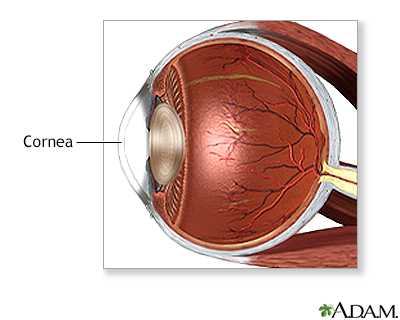Corneal transplant - discharge
Keratoplasty - discharge; Penetrating keratoplasty - discharge; Lamellar keratoplasty - discharge; DSEK - discharge; DMEK - dischargeThe cornea is the clear outer lens on the front of the eye. A corneal transplant is surgery to replace the cornea with tissue from a donor. It is one of the most common transplants done.
Corneal transplant
The cornea is the clear outer lens on the front of the eye. A corneal transplant is surgery to replace the cornea with tissue from a donor. It is o...

When You're in the Hospital
You had a corneal transplant. There are two ways to do this.
- In one (penetrating or PK), most of the tissue of your cornea (the clear surface on the front of your eye) was replaced with tissue from a donor. During your surgery, a small round piece of your cornea was taken out. Then the donated cornea was sewn into the opening of your eye.
- In the other (lamellar keratoplasty or Descemet stripping and endothelial keratoplasty - DSEK), only the outer layers (lamellar) or inner layers (DSEK) of the cornea are transplanted. Recovery is often faster with this method.
Numbing medicine was injected into the area around your eye so you did not feel any pain during surgery. You may have taken a sedative to help you relax.
What to Expect at Home
If you had a PK, the first stage of healing will take about 3 weeks. After this, you will likely need contact lenses or glasses. These may need to be changed or adjusted several times in the first year after your transplant.
If you had a lamellar keratoplasty or DSEK, visual recovery is often quicker and you may even be able to use your old glasses.
Self-care
Do not touch or rub your eye.
If you had a PK, your surgeon probably put a patch over your eye at the end of surgery. You can remove this patch the next morning but you will probably have an eye shield for sleeping. This protects the new cornea from injury. During the day, you will probably need to wear dark sunglasses.
If you had a DSEK, you probably won't have a patch or shield after the first day. Sunglasses will still be helpful.
You should not drive, operate machinery, drink alcohol, or make any major decisions for at least 24 hours after surgery. The sedative will take this long to fully wear off. Before it does, it may make you very sleepy and unable to think clearly.
Limit activities that could make you fall or increase pressure on your eye, such as climbing a ladder or dancing. Avoid heavy lifting. Try not to do things that place your head lower than the rest of your body. It may help to sleep with your upper body elevated by a couple pillows. Stay away from dust and blowing sand.
Follow your surgeon's instructions for using eye drops carefully. The drops help prevent infection. They also help prevent your body from rejecting your new cornea.
Follow up with your surgeon as directed. You may need to have stitches removed, and your surgeon will want to check your healing and eyesight.
When to Call the Doctor
Contact your surgeon if you have:
- Decreased vision
- Flashes of light or floaters in your eye
- Light sensitivity (sunlight or bright lights hurt your eye)
- More redness in your eye
-
Eye pain
Eye pain
Pain in the eye may be described as a burning, throbbing, aching, or stabbing sensation in or around the eye. It may also feel like you have a forei...
 ImageRead Article Now Book Mark Article
ImageRead Article Now Book Mark Article
References
Boyd K. What to expect when you have a corneal transplant. American Academy of Ophthalmology. www.aao.org/eye-health/tips-prevention/what-to-expect-when-you-have-corneal-transplant. Updated February 28, 2020. Accessed August 22, 2024.
Dunbar GE, Titus M, Stein JD, Meijome TE, Mian SI, Woodward MA. Patient-reported outcomes after corneal transplantation. Cornea. 2021;40(10):1316-1321. PMID: 33758138 pubmed.ncbi.nlm.nih.gov/33758138/.
Pierson KL, Holland EJ, Mannis MJ. Corneal transplantation in ocular surface disease. In: Mannis MJ, Holland EJ, eds. Cornea. 5th ed. Philadelphia, PA: Elsevier; 2022:chap 170.
Romano D, Aiello F, Parekh M, et al. Incidence and management of early postoperative complications in lamellar corneal transplantation. Graefe's Archive for Clinical and Experimental Ophthalmology. 2023;261(11):3097-3111. PMID: 37103622 pubmed.ncbi.nlm.nih.gov/37103622/.
Venkateswaran N, Nikpoor N, Perex VL. Surgical ocular surface reconstruction. In: Yanoff M, Duker JS, eds. Ophthalmology. 6th ed. Philadelphia, PA: Elsevier; 2023:chap 4.33.
Zhou Y, Wang T, Tuli SS, Steigleman WA, Shah AA. Overview of corneal transplantation for the nonophthalmologist. Transplant Direct. 2023;9(2):e1434. PMID: 36700069 pubmed.ncbi.nlm.nih.gov/36700069/.
Review Date: 8/5/2024
Reviewed By: Franklin W. Lusby, MD, Ophthalmologist, Lusby Vision Institute, La Jolla, CA. Also reviewed by David C. Dugdale, MD, Medical Director, Brenda Conaway, Editorial Director, and the A.D.A.M. Editorial team.








